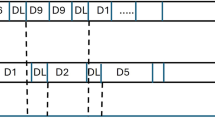Abstract
Slotted ALOHA is a well-known multiple access control protocol that devices use to access a radio channel in wireless networks. Age of information (AoI) is a key network performance indicator that represents the elapsed time between the time data is generated and the time data is received. Threshold-based ALOHA, a variant of the slotted ALOHA, uses a threshold and a transmission probability to send data and meet its requirement of average AoI (AAoI), in which however energy consumption is not discussed. It is crucial that a device operates energy-efficiently to reduce energy consumption, which is conducive to extending the life of the device and reducing greenhouse gas emissions. Therefore, this paper proposes a modified threshold ALOHA in low-duty-cycle wireless networks, called LBG-threshold-ALOHA, in which a device looks up whether sensing data is generated in prior N slots before its data generation/transmission. Instead of generating data in each transmission, the LBG-threshold ALOHA uses data generated in prior N slots to send, which reduces the activity of data generation and thus yields lower energy consumption. The characteristic of lower energy consumption is beneficial to produce a lower AAoI on a network constrained by low energy consumption. Simulation results show that, under an upper limit on the mean energy consumption, the LBG-threshold-ALOHA yields a lower minimum AAoI compared to the original threshold ALOHA.








Similar content being viewed by others
Explore related subjects
Discover the latest articles, news and stories from top researchers in related subjects.References
Kassab, W., & Darabkh, K. A. (2020). A-Z survey of internet of things: Architectures, protocols, applications, recent advances, future directions and recommendations. Journal of Network and Computer Applications, 163, 102663. https://doi.org/10.1016/j.jnca.2020.102663
Seferagić, A., Famaey, J., Poorter, E. D., & Hoebeke, J. (2020). Survey on wireless teechnology trade-offs for the industrial internet of things. Sensors, 20(2), 488. https://doi.org/10.3390/s20020488
Khan, M., Silva, B. N., & Han, K. (2016). Internet of Things based energy aware smart home control system. IEEE Access, 4, 7556–7566. https://doi.org/10.1109/ACCESS.2016.2621752
Alam, M. M., Malik, H., Khan, M. I., Pardy, T., Kuusik, A., & Le Moullec, Y. (2018). A survey on the roles of communication technologies in IoT-based personalized healthcare applications. IEEE Access, 6, 36611–36631. https://doi.org/10.1109/ACCESS.2018.2853148
Ding, J., Nemati, M., Ranaweera, C., & Choi, J. (2020). IoT connectivity technologies and applications: A survey. IEEE Access, 8, 67646–67673. https://doi.org/10.1109/ACCESS.2020.2985932
Pasricha, S., Ayoub, R., Kishinevsky, M., Mandal, S. K., & Ogras, U. Y. (2020). A survey on energy management for mobile and IoT devices. IEEE Design & Test, 37(5), 7–24. https://doi.org/10.1109/MDAT.2020.2976669
Tegos, S. A., Diamantoulakis, P. D., Lioumpas, A. S., Sarigiannidis, P. G., & Karagiannidis, D. K. (2020). Slotted ALOHA with NOMA for the next generation IoT. IEEE Transactions on Communications, 68, 6289–6301.
Yates, R. D., Sun, Y., Brown, D. R., Kaul, S. K., Modiano, E., & Ulukus, S. (2021). Age of information: An introduction and survey. IEEE Journal on Selected Areas in Communications, 39(5), 1183–1210. https://doi.org/10.1109/JSAC.2021.3065072
Atabay, D. C., Uysal, E., & Kaya, O. (2020). Improving age of information in random access channels. In IEEE INFOCOM 2020—IEEE conference on computer communications workshops (INFOCOM WKSHPS) (pp. 912–917). https://doi.org/10.1109/INFOCOMWKSHPS50562.2020.9163053
Chen, H., Gu, Y., & Liew, S.-C. (2020). Age-of-Information dependent random access for massive IoT networks. In IEEE INFOCOM—IEEE conference on computer communications workshops (INFOCOM WKSHPS) (pp. 930–935). https://doi.org/10.1109/INFOCOMWKSHPS50562.2020.9162973
Yavascan, O. T., & Uysal, E. (2020). Analysis of age-aware slotted ALOHA. In 2020 IEEE Globecom Workshops (GC Wkshps) (pp. 1–6). https://doi.org/10.1109/GCWkshps50303.2020.9367557
Yavascan, O. T., & Uysal, E. (2021). Analysis of slotted ALOHA with an age threshold. IEEE Journal on Selected Areas in Communications, 39(5), 1456–1470. https://doi.org/10.1109/JSAC.2021.3065043
Alippi, C., Anastasi, G., Di Francesco, M., & Roveri, M. (2009). Energy management in wireless sensor networks with energy-hungry sensors. IEEE Instrumentation & Measurement Magazine, 12(2), 16–23. https://doi.org/10.1109/MIM.2009.4811133
Shu, T., Xia, M., Chen, J., & De Silva, C. (2017). An energy efficient adaptive sampling algorithm in a sensor network for automated water quality monitoring. Sensors, 17(11), 2551. https://doi.org/10.3390/s17112551
Halgamuge, M. N., Zukerman, M., Ramamohanarao, K., & Vu, H. L. (2009). An estimation of sensor energy consumption. Progress In Electromagnetics Research B, 12, 259–295. https://doi.org/10.2528/PIERB08122303
Obaidat, M. S., Nicopolitidis, P., & Zarai, F. (2015). Modeling and simulation of computer networks and systems: Methodologies and applications (1st ed.). Morgan Kaufmann.
Funding
The authors declare that no funds, grants, or other support were received during the preparation of this manuscript.
Author information
Authors and Affiliations
Contributions
All authors contributed to the study conception, design, analysis, coding, and writing.
Corresponding author
Ethics declarations
Conflict of interest
The authors declare that they have no conflict of interest.
Additional information
Publisher's Note
Springer Nature remains neutral with regard to jurisdictional claims in published maps and institutional affiliations.
Rights and permissions
Springer Nature or its licensor (e.g. a society or other partner) holds exclusive rights to this article under a publishing agreement with the author(s) or other rightsholder(s); author self-archiving of the accepted manuscript version of this article is solely governed by the terms of such publishing agreement and applicable law.
About this article
Cite this article
Tzeng, SS., Lin, YJ. & Lin, YT. Threshold ALOHA with sensing data lookup in low-duty-cycle wireless networks. Telecommun Syst 86, 757–767 (2024). https://doi.org/10.1007/s11235-024-01145-2
Accepted:
Published:
Issue Date:
DOI: https://doi.org/10.1007/s11235-024-01145-2




